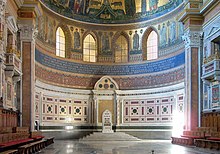
Back نظام حكم أسقفي Arabic Episkopalismus German Episcopalismo Spanish نظام اسقفی Persian Episkopaalisuus Finnish Système épiscopal French Episzkopalizmus Hungarian Episkopal ID Episcopalismo Italian 監督制 Japanese
This article needs additional citations for verification. (August 2015) |
| Ecclesiastical polity |
|---|

An episcopal polity is a hierarchical form of church governance in which the chief local authorities are called bishops. The word "bishop" here is derived via the British Latin and Vulgar Latin term *ebiscopus/*biscopus, from the Ancient Greek ἐπίσκοπος epískopos meaning "overseer".[1][2] It is the structure used by many of the major Christian Churches and denominations, such as the Catholic, Eastern Orthodox, Oriental Orthodox, Church of the East, Anabaptist, Lutheran, and Anglican churches or denominations, and other churches founded independently from these lineages.[citation needed] Many Methodist denominations have a form of episcopal polity known as connexionalism.
- ^ Harper, Douglas. "bishop". Online Etymology Dictionary.
- ^ ἐπίσκοπος. Liddell, Henry George; Scott, Robert; A Greek–English Lexicon at the Perseus Project.